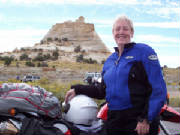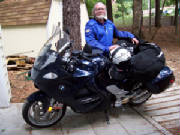 Motorcycle
versus Vespa
Motorcycle
versus Vespa 
 Motorcycle
versus Vespa
Motorcycle
versus Vespa 
John
and Susan House
My wife Susan and I last September rode US 50 most of
the way from the East Coast, turning southwest on I-15 to visit friends in
southern
In September, strong desert winds are a fairly frequent condition, usually from the southwest. This is an issue not only for you as a scooter rider, but in terms of the effect on traffic around you, particularly large trucks. Passing, or being passed by, one of these in strong winds, is an exercise in physical stamina and mental alertness. There is not only the strong air turbulence that accompanies a big square vehicle blasting through the air; there is also an effect due to the truck blocking side winds. You are riding along in a strong wind having to adjust and lean a bit to stay straight in your lane, but suddenly as you are passed by (or pass, not so likely on your scooter, but perhaps you’re both moving at a lower speed in a town) a big truck, the wind is blocked by the truck. As soon as that happens, either you will alertly shift your steering and weight to adjust for no longer having the wind blowing you sideways, or you will forget this and suddenly find yourself leaning to the opposite side where the wind is no longer pushing against you. That’s not good: you’ll be moving toward the side of a big truck right next to you. Even if you’re not a physics major, you can figure this is not going to be a happy experience. And there’s more, because in a few seconds at most, you or the truck will move ahead, and just as suddenly, you’re hit by the same wind you were momentarily sheltered from, scrambling to re-adjust again. Since it’s usually the truck passing you, you’ll also spend a few seconds dealing with the vortex of air caused behind any large truck moving through air, which causes low pressure behind the truck and the situation of feeling tugged toward the back corner of the truck. US 50 is a truck route, especially in the West, so you’ll need to feel comfortable in this sort of situation before you start the trip. Go out on your local highways and find some trucks to practice with! It can be done, but you will be much better off to have mastered the skills before you start the Big Ride.
Heat can be a big factor. If you’re used to traveling long hours in heat, or are an outdoor sports enthusiast, you’ll know what you need to do. If not, talk to people who deal with long periods of heat – distance bicyclists and runners are a good source of information. This is a little crude, no offense, but you might want to turn your internet search browser to looking for the term “monkey butt”. That’s a rude phrase that describes a common issue among distance bicycle and motorcycle riders (or cowboys who spend all day in the saddle, same deal). It is NOT a joke, despite the funny name. It can turn into a serious medical issue, so study up and be prepared. If you can, try to add the search term “Flash Gordon” to the “monkey butt” search. This is the actual name of a physician who rides motorcycles and does sport medicine. He has written some good articles on this subject – if you can’t find the articles on the web, find his address and email him. Getting this right can be the difference between a great adventure or a horrible experience.
For people who can chat knowledgably about the issues of a woman rider, look up organizations for women motorcyclists, such as the “Motor Maids” (one of the oldest organizations), or “Women On Wheels”. Such internet sites usually have links to discussion forums where you can “talk” with experienced people who can appreciate what you’re trying to do and won’t waste your time or theirs trying to tell you to stop riding and take up knitting (nothing against knitting).
Interstate “qualification” – state laws differ
about small displacement engines like yours on high-speed roads – applies.
You won’t always be on just highway 50.
There are parts where you’ll be merged with other routes, and in some
places that can include a stretch of high-speed highway.
Also, you might want to go around rather than through big city traffic.
Example: you will spend a short time, perhaps a half hour, in Kentucky
going around the south side of Cincinnati OH on the interstate rather than
tackle riding through the busiest parts of the city especially if it’s rush
hour when you get there. (That
routing decision occurs just as you finish crossing
Riding west of the
Mr. Berg’s book is a good resource, but keep in mind that trip was made in a camper/van rig, and you are dealing with some variables not part of the 4-wheel adventure. Others on the motorcycle links dealing with US 50 will have useful information, and many of the people writing there will be happy to exchange notes with you.
People will tell you doing this on two wheels is suicide. Not at all, provided you recognize that there is a greater risk exposure and plan/ride accordingly. Others will tell you it simply is impossible on a scooter. This is also wrong. Among motorcyclists, there is a brave, resourceful, and slightly lunatic group who think long distance riding is the best thing in the world. Among them, there is the Iron Butt Association, which sponsors competitions in which people ride many thousands of miles around the country, competing to do it quickly while also collecting extra points for visiting a list of places not directly on the shortest route. It’s not fully exclusively motorcycles that run this grueling competition; it has been done on scooters, and with a respectable score, much to the chagrin of people who finished lower with big fancy motorcycles! Not everyone does this, and I’m not recommending it. Just so you know people who say it’s impossible are wrong.
Best wishes on your adventure! John House